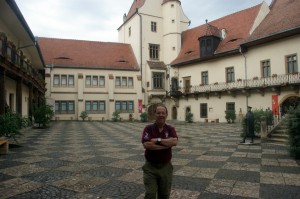
If I could not use “rain” to describe the weather, I probably would have been at a loss for words on most of this trip. Once again, rain descended, but at least this time it was after a partly sunny morning. And if I could not use “cute” to describe my latest flirtation with an Eastern European/Romanian city–Timișoara–I would be hard pressed to find a substitute.
The difference in this western Romanian city is the Austrian influence, since many of the majestic buildings around the ever-present squares are from the Austrian period, which began when Austria, under Austria’s most famous general, Eugene of Savoy (you thought you’d heard the last of him) liberated Timisoara from the Turks–1718 or so. Hence the palatial Baroque 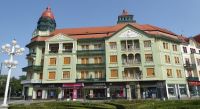 buildings, together with two plague monuments. There’s only one “plaque” left from Turkish days–on the rebuilt (in the Austrian style) building atop what was once a Turkish bath. The major museum is in an old Austrian palace, built atop Roman ruins, while the art museum is in what had been the Austrian governor general’s abode. Many of the older buildings are being renovated.
buildings, together with two plague monuments. There’s only one “plaque” left from Turkish days–on the rebuilt (in the Austrian style) building atop what was once a Turkish bath. The major museum is in an old Austrian palace, built atop Roman ruins, while the art museum is in what had been the Austrian governor general’s abode. Many of the older buildings are being renovated.
I came for more than the baroque, however, because Timisoara is renowned for its architectural blending, which supplements and complements the many ethnic groups that have blended here in the Banat area (I’m out of Dracula’s lair, Transylvania). The National Theater, on the most famous (recently anyway) square, which I’ll explain below, offers plays in German, 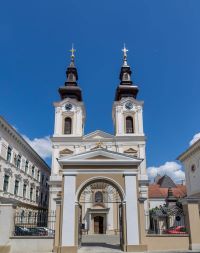 Hungarian, and Romanian. Another square is dominated by the green building of the Serbian bishop, together with the Serbian Church. The architectural styles include: major rebuilding of fortifications in the early 1850s, following the suppression of the Hungarian revolution (the army sided with Austria here, and earned garrison duty in the barracks built atop the former city walls); a major Romanian Orthodox cathedral, built in
Hungarian, and Romanian. Another square is dominated by the green building of the Serbian bishop, together with the Serbian Church. The architectural styles include: major rebuilding of fortifications in the early 1850s, following the suppression of the Hungarian revolution (the army sided with Austria here, and earned garrison duty in the barracks built atop the former city walls); a major Romanian Orthodox cathedral, built in 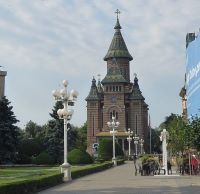 the 1940s and one of the largest in Romania. King Michael’s last appearance as ruler of Romania was at its 1947 consecration.
the 1940s and one of the largest in Romania. King Michael’s last appearance as ruler of Romania was at its 1947 consecration.
Around the turn of the century, as well, the neo-Gothic of the Hungarian millennium church was built (Hungary’s conversion to Christianity was in 1000, supposedly on Christmas day; services are conducted in the three main languages, and also in Italian!). Art Deco, Art Nouveau, and Secessionist buildings dot the downtown area. Interspersed are the Communist-era buildings. My guide said people walked on the one side of the major square that had the Austrian fin-de-siecle buildings, while the servants used the Soviet side.
Perhaps you know about the revolution of 1989 that toppled the regime in Romania. It was the only Eastern bloc turnover that was marked by violence. It began here in Timișoara, in that square mentioned above, when one of the priests (I understand he’s still alive) denounced the Ceausescu regime; 150,000 people jammed the streets, and the police opened fire, killing over 20 protesters. The anti-tyranny movement (as they called it here) spread from Timisoara to the other big cities, and despite the rumors in Timisoara (that my guide had experienced) of massive Communist reprisals, the army went over to the revolution, and Ceausescu and his wife 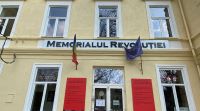 were executed. We walked by the Museum of the Revolution, and I said I wanted to go in; it’s nothing we have at home! As it turned out, the museum is the brainchild of one of the revolutionaries, wounded in the fighting, who walks with a cane from the bullet. He gave us a tour of the museum, along with his personal story. He had a 25-minute film, but we were pressed for time. I am in Timisoara for only a few hours; I had about six hours layover, and since I know what airports look like (this one is small and busy), I asked my travel agent for a tour of Timisoara. After all, I needed to sample as many of the Romanian cities as possible to see whether, as Professor Pana put it, I’m still in love.
were executed. We walked by the Museum of the Revolution, and I said I wanted to go in; it’s nothing we have at home! As it turned out, the museum is the brainchild of one of the revolutionaries, wounded in the fighting, who walks with a cane from the bullet. He gave us a tour of the museum, along with his personal story. He had a 25-minute film, but we were pressed for time. I am in Timisoara for only a few hours; I had about six hours layover, and since I know what airports look like (this one is small and busy), I asked my travel agent for a tour of Timisoara. After all, I needed to sample as many of the Romanian cities as possible to see whether, as Professor Pana put it, I’m still in love.
Great visit. On to Lvov in the Ukraine for the next two days.